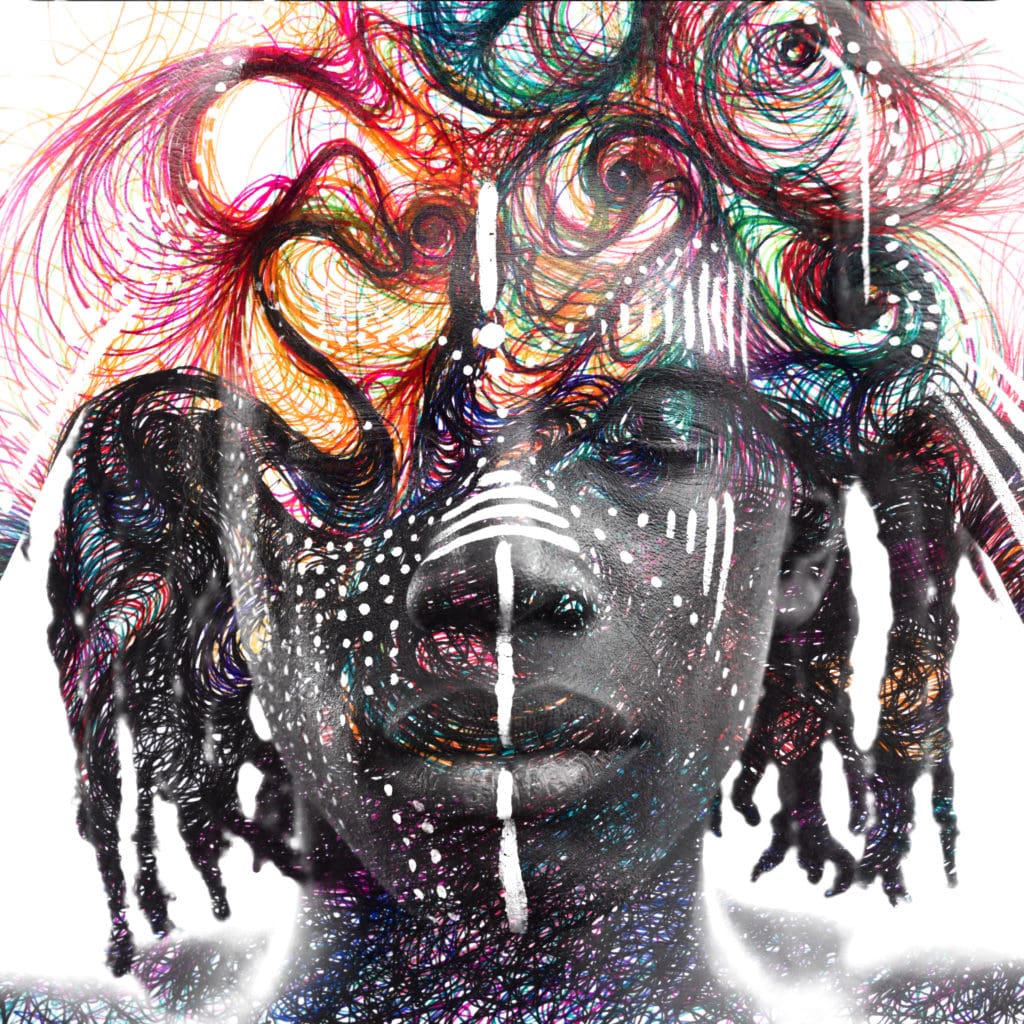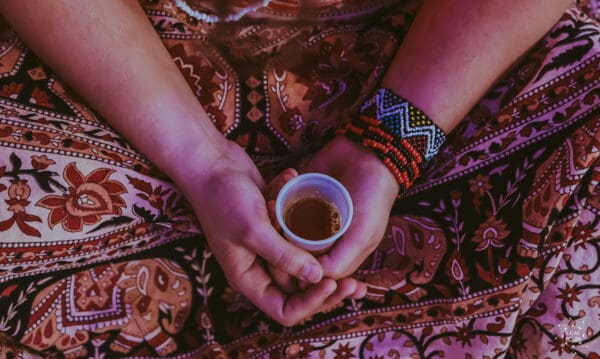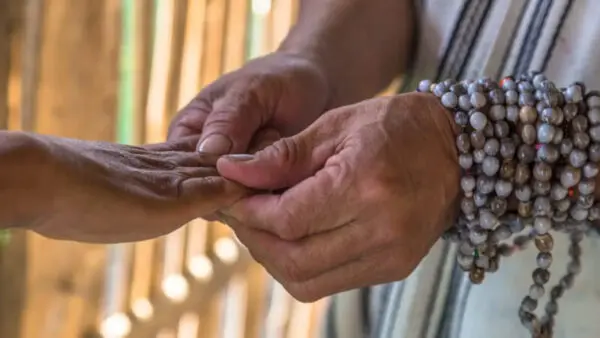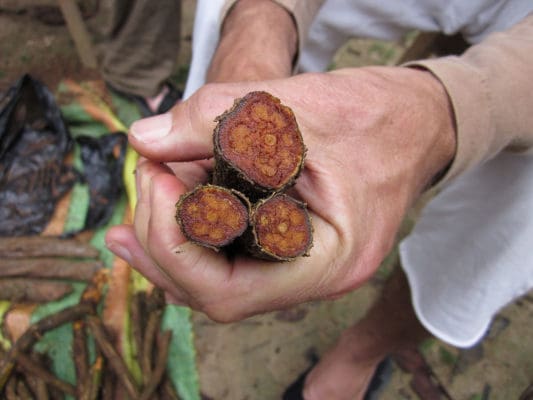Ayahuasca is a powerful and sacred plant medicine. This psychedelic brew has changed the lives of thousands, including indigenous people. It has been used for centuries and aids modern-day Westerners in their search for spiritual development. Additionally, new research on ayahuasca’s role in treating post-traumatic stress disorder (PTSD) and depression is emerging and expanding the brew’s possibilities. However, it is hard to convey the beauty of the experience to others. An ayahuasca ceremony can be incredibly personal. However, through modern-day ayahuasca art, artists express the beauty and spirit of the brew. Keep reading to learn ayahuasca basics, a brief history on psychedelic art, and modern indigenous artists to know.
What Is Ayahuasca?
Ayahuasca is a brew of two plant ingredients: the banisteriopsis caapi (ayahuasca) vine and psychotria viridis leaf. The ayahuasca vine has monoamine oxidase inhibitors (MAOIs), while the psychotria viridis leaf contains N,N-dimethyltryptamine (DMT). DMT is a potent psychedelic molecule responsible for most of the psychoactive effects of ayahuasca.
Indigenous people in countries like Colombia, Brazil, and Peru have been using ayahuasca for hundreds of years as medicine and a tool and ritual for spiritual growth. As the word spread of ayahuasca’s powers, many Westerners started traveling to these countries where the plant medicine is legally available. During such retreats, the tea is usually consumed on multiple nights, with healing and integration work done during the day. An ayahuasca facilitator, sometimes termed a curandero(a) or shaman, leads these ceremonies.
DMT is a Schedule I drug which classifies ayahuasca as illegal in the U.S. However, two American churches (Unaio Do Vegetal and Santo Daime) are allowed to consume the tea legally under the Religious Freedom Restoration Act.
In addition to spiritual development, ayahuasca shows promise in mental health treatment. Research suggests that it can activate repressed memories, which is one reason why it is being studied as a psychedelic therapy for PTSD and depression. Some people who take ayahuasca report working through upsetting memories or traumatic experiences, allowing them to develop a healthier new perspective.
Ayahuasca’s Inspiring Effects
After ingesting the brew, ayahuasca takes about 20 to 60 minutes to take effect. An early stage of the ayahuasca experience is known as “the purge” or la purga. Vomiting, diarrhea, gas, crying, screaming, sneezing, yawning, sweating, and shaking can all occur. While this sounds can be challenging, the purge is traditionally considered to be an essential part of the experience. Some believe the purge releases thoughts and behavior patterns no longer serving them and clears the path for spiritual awakening.
During the ayahuasca trip, people report beautiful geometric visuals and swirling color trails. In addition to the hallucinogenic properties, ayahuasca is known to present a psychological “mirror” of sorts. This can manifest as an unflinching view of oneself, flaws and all. When coming down from the trip, these awakenings can be valuable in making life decisions and confronting the ego. Ideally, this comes with sufficient integration work, which is why it is advised to consume ayahuasca under the supervision of a trained and responsible guide.
Ayahuasca can be a powerful tool for healing and transformation. People often make much-needed life changes after taking part in a ceremony. However, the trip itself can be ineffable and challenging to describe and convey to others. Psychedelic art, ayahuasca-inspired art, in particular, can help relay the experience to others.
The History of Psychedelic Art
Psychedelic art refers to art inspired by or meant to recreate the experience of psychedelic medicines such as ayahuasca, lysergic acid diethylamide (LSD), psilocybin, and more. The genre also includes art created during a psychedelic trip. There is no research directly studying the link between art and psychedelics. However, a 2018 study on psilocybin for patients with treatment‐resistant depression suggests that the psychedelic increases insightfulness and openness, which are associated with creativity.
While one can assume indigenous people created psychedelic art for centuries, if not millennia, psychedelic art became popular in the Western world during the 1960s as part of the hippie counterculture movement. Notable traits of art from this period include kaleidoscopic patterns, bright colors, and distorted and ethereal visuals. Famous psychedelic artists from this period include Wes Wilson, Rick Griffin, and Victor Moscoso. Their work, and others, made their way onto political anti-war posters, album covers, and eventually into mainstream advertising.
Although many psychedelics, such as ayahuasca, are indigenous, most of the well-known psychedelic artists from this time frame were white and male. Black artists and women are especially underrepresented. One notable female psychedelic artist is Marije Koger, known as the Mother of Psychedelic Art. She is best known for her album cover artworks for the Beatles.
Today, the internet is changing everything. Black artists, such as Vernon O’Meally, who creates vivid psychedelic art using charcoal, are finally being recognized. Social media and sharing platforms such as Instagram, Tumblr, Pinterest, and Reddit are finally showcasing indigenous ayahuasca artists.
Contemporary Ayahuasca Art
The first name to know is Pablo Amaringo (1938-2009), who is considered the father of contemporary ayahuasca visionary art. The Peruvian artist is known for his detailed, geometric, and nature-based paintings inspired by ayahuasca. Armaringo is also an ayahuasca shaman, although he left his work as a shaman to start an art school where many students learned from his sacred techniques.
Other modern ayahuasca artists include Mariela de la Paz, a Chilean-born painter. In addition to depictions of psychedelic plant medicine, de la Paz often incorporates imagery of the divine feminine. These themes are especially noted in her “The Women of the Earth” series.
Geenss Archenti Flores is a contemporary Peruvian artist who depicts indigenous people, often partaking in plant medicine ceremonies. In addition to being inspired by plant medicine, Flores uses natural plant pigments to paint, often on banana leaf paper.
These are just a few of the artists bringing the experience of ayahuasca to the world with their art. Since an ayahuasca experience is so individualized, one may never be able to clearly express their personal experience to others. However, through modern ayahuasca artists, particularly indigenous ayahuasca artists, the magic of plant medicine is presented to the world in an illustrious form.







